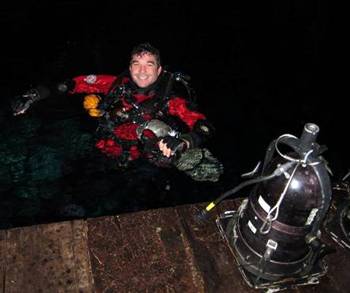Meadows Center diver part of 'First Americans' find in Yucatan
Posted by Jayme Blaschke
University News Service
May 19, 2014
|
|
The discovery of a well-preserved human skeleton deep within a submerged Yucatan cave is shedding new light on the debate over who were the first Americans, and a Texas State University researcher is part of the archaeological dive team.
Sam Meacham with The Meadows Center for Water and the Environment is one of the project survey divers for the Hoyo Negro site. With 20 years of cave diving experience and expertise in exploring and mapping underwater caves in the Yucatan, he has been part of the Hoyo Negro project since 2008.
The skull from the approximately 12,000-year-old skeleton looks markedly different from that of modern Native Americans, but DNA extracted from one of its teeth shares a distinctive genetic signature with them. This suggests that the earliest Americans and Native Americans share a single source population, and that the Paleoamericans represent an early population expansion out of Beringia, the landmass that once connected Asia and North America.
The findings are detailed in the May 16 issue of the journal Science.
"The discovery in Hoyo Negro is the tip of a large iceberg of information about what the planet looked like and who and what inhabited it during the last ice age," Meacham said. "What fascinates me and Fritz (Hanselmann, chief underwater archaeologist with The Meadows Center) are how sites like Hoyo Negro might be connected to our own spring lake through similar cultural patterns and activities.
"Hoyo Negro also highlights the broad range of project types and the capabilities that we possess at The Meadows Center--be they deep ocean shipwrecks, coastal sites or flooded caves," he said. "I personally feel so privileged to be involved in a project as significant as Hoyo Negro and to know that I am helping to grow an important program at The Meadows Center to promote the exploration and better understanding of the underwater environment."
On the basis of genetics, modern Native Americans are thought to descend from Siberians who moved into eastern Beringia between 26,000 and 18,000 years ago and then spread southward. Despite widespread support for this idea, the ancestry of the earliest Americans is still debated because the facial features of the oldest American skeletons don't look much like those of modern Native Americans. This has led some researchers to suggest that the Americas were colonized by separate migration events from different parts of Eurasia.
